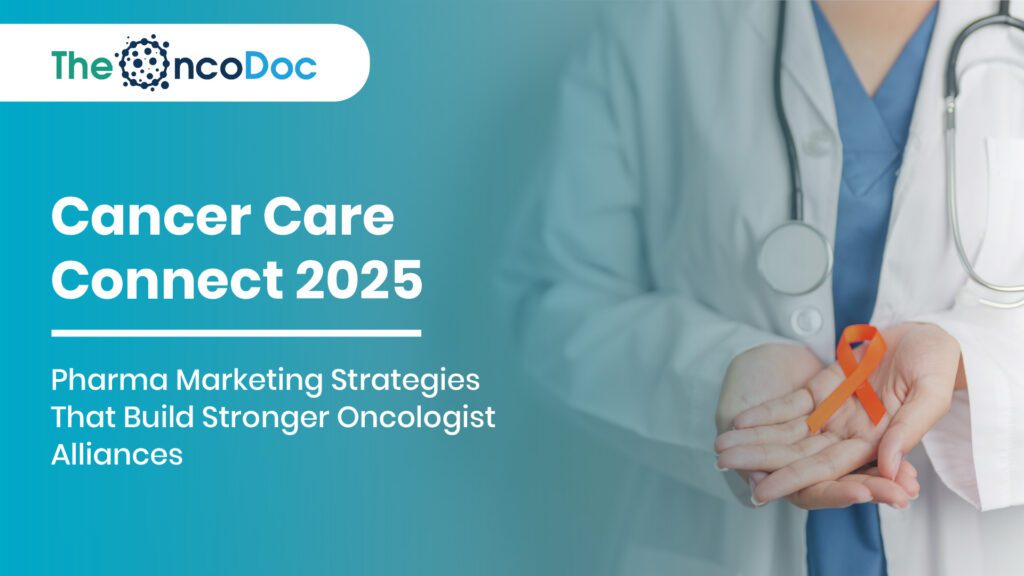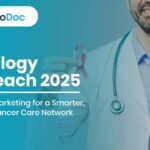Introduction: Beyond the Pill, Towards the Partnership
The oncology marketing landscape in 2025 is no longer defined by drug promotion alone—it’s about being a trusted partner in an oncologist’s fight against cancer. Pharma companies are realizing that deep relationships, actionable insights, and multi-channel support are the true drivers of influence.
Today’s oncologists face a tidal wave of clinical updates, complex therapy regimens, and rising patient expectations. In this environment, marketers who can curate clarity, deliver value, and integrate seamlessly into the care continuum are the ones breaking through the noise.
This article explores the next-generation pharma marketing tactics that go beyond traditional detailing—strategies designed to foster stronger alliances with oncologists, improve patient outcomes, and position brands as indispensable partners in cancer care.
1. Moving from Product-Centric to Problem-Centric Marketing
The most effective campaigns in oncology no longer start with “here’s our drug,” but rather with “here’s the problem we can solve together.”
Instead of focusing solely on trial data and dosing, pharma teams are creating solution-based narratives that integrate:
- Diagnostic pathway improvements.
- Side effect management resources.
- Patient education tools that reduce non-adherence.
By aligning with oncologists’ daily challenges, brands become part of their problem-solving toolkit. This approach shifts the conversation from transactional to collaborative, making the brand a genuine partner in care delivery. Over time, such alignment deepens trust and encourages ongoing professional engagement.
2. Precision Targeting Through Clinical Intelligence
The precision medicine revolution has also transformed marketing. Campaigns now leverage real-world evidence (RWE) and predictive analytics to identify:
- Oncologists treating specific patient subgroups.
- Centers with high clinical trial activity.
- Regions with gaps in early detection infrastructure.
Such targeting ensures that every outreach effort feels relevant and timely. By focusing resources where they can have the greatest impact, brands improve both efficiency and relationship depth. This also allows marketing teams to avoid irrelevant touchpoints, preserving professional goodwill.
3. GP and Specialist Network Synchronization
Cancer diagnosis often begins outside the oncology office. Engaging GPs, pathologists, and radiologists as part of a networked marketing approach increases timely referrals.
Pharma brands are:
- Offering rapid e-consult platforms for GPs to connect with oncologists.
- Sponsoring diagnostic workshops where specialists share case learnings.
- Providing co-branded educational content for waiting rooms.
Creating a synchronized communication chain between specialties ensures that no patient falls through the cracks. It also reinforces the brand as a connector in the broader healthcare ecosystem, demonstrating its value beyond the prescription.
4. Omnichannel Education Ecosystems
In 2025, the most successful pharma marketing strategies integrate in-person, digital, and mobile experiences into a single learning ecosystem for oncologists.
Examples include:
- Conference presentations streamed live into clinic apps.
- On-demand CME micro-modules via WhatsApp.
- Integrated digital libraries with both research summaries and patient leaflets.
This blended approach allows oncologists to engage with content whenever and wherever it suits their schedule. The seamless integration of platforms also reduces the cognitive load of managing multiple information sources, improving both adoption and retention.
5. Emotional Intelligence in Campaign Design
Marketing to oncologists requires a delicate balance between clinical rigor and emotional resonance. Campaigns that combine compelling patient stories with actionable scientific updates build lasting trust.
A patient case video showing a complete response to therapy can have greater recall value than a 20-page data sheet—especially when followed by a concise scientific breakdown. Emotional framing also helps physicians connect the data to real-world patient impact, reinforcing the relevance of the therapy and humanizing the science behind it.
6. AI-Powered Field Force Augmentation
The medical representative (MR) role has evolved into a data-driven clinical liaison. AI tools now guide reps on:
- Which oncologist to meet next based on prescription patterns.
- What content format each doctor engages with most.
- Which clinical trials are relevant to their patient base.
This ensures conversations are highly personalized and data-backed. It also makes interactions more valuable for the oncologist, who receives tailored, clinically relevant insights rather than generic sales pitches. In turn, these optimized visits increase both brand credibility and campaign ROI.
7. Mapping the Triggers That Drive Therapy Adoption
Understanding what prompts oncologists to switch, add, or initiate therapies is critical. In 2025, top triggers include:
- Compelling survival benefit in new trial data.
- Positive real-world safety outcomes.
- Peer endorsements during tumor board discussions.
By mapping these triggers, pharma companies can time their communications for maximum relevance. Targeted engagement around these moments significantly shortens adoption timelines and boosts therapy consideration rates.
8. Localized Oncology Insights
One-size-fits-all messaging fails in oncology. Marketers now deploy hyperlocal insights such as:
- Regional cancer incidence trends.
- Access-to-care barriers unique to rural vs. urban hospitals.
- Language-specific patient information kits.
Tailoring messages to a region’s specific realities makes campaigns far more persuasive. This not only improves engagement but also demonstrates that the brand understands the oncologist’s unique practice environment.
9. Building Clinical Collaboration Platforms
Pharma-led digital platforms now serve as:
- Secure case discussion boards.
- Clinical trial recruitment tools.
- AI-powered literature search engines.
These platforms encourage ongoing engagement beyond the sales cycle. By facilitating professional collaboration and knowledge sharing, they establish the brand as an indispensable partner in the oncologist’s daily work.
10. Outcome-Based KPIs in Oncology Marketing
The era of tracking “number of calls made” is over.
Marketers are now measured against:
- Number of early-stage patients referred post-campaign.
- Usage of brand-supported decision tools in tumor boards.
- Increase in screening rates in targeted regions.
Focusing on outcomes aligns marketing efforts with the ultimate goal of improving patient survival. This shift also provides a clear, measurable link between campaign activities and their real-world healthcare impact.
11. Strategic Partnerships with Medical Societies
By co-developing guideline summaries, CME events, and joint publications, pharma brands integrate themselves into the continuing education pipeline.
These partnerships also help combat skepticism around industry involvement by ensuring transparency and peer review.
Medical societies often have long-standing trust with oncologists, which can be leveraged to improve campaign credibility. Joint educational programs also allow brands to present new therapies in the context of the latest research, making the content more relevant and authoritative.
12. Gamification in Oncologist Engagement
Gamified platforms are now used for CME tracking, case challenges, and diagnostic quizzes. This approach boosts participation while creating a friendly competitive environment that fosters peer learning.
Leaderboards, achievement badges, and time-bound case challenges keep oncologists returning to the platform. By blending education with engagement, brands ensure knowledge retention while maintaining an enjoyable learning experience.
13. Patient Advocacy Integration
Linking with advocacy groups ensures campaigns remain patient-centered. Advocacy partnerships also open doors to patient-led awareness events, where oncologists engage with the public directly.
This collaboration provides valuable feedback from the patient community, helping shape future campaigns and resources. It also positions the pharma brand as an active contributor to the broader fight against cancer rather than just a drug supplier.
14. Harnessing Wearables and Remote Monitoring Data
Wearable devices now supply oncologists with real-time patient health metrics, which pharma companies use to demonstrate drug impact in day-to-day life—not just trial settings.
Integration of wearable data into brand-supported dashboards gives oncologists a fuller picture of patient outcomes. Over time, this data can also be used to support post-marketing surveillance, adding a real-world evidence layer to the brand’s clinical story.
15. Crisis Communication Playbooks
From drug shortages to trial safety alerts, brands are preparing proactive crisis communication plans to protect trust and minimize misinformation.
Having pre-approved, evidence-backed responses ready for potential issues allows pharma teams to act swiftly. A well-handled crisis can actually strengthen a brand’s reputation by demonstrating responsibility and transparency.
16. Voice Search Optimization for Oncologist Queries
With oncologists increasingly using voice assistants for quick fact checks, pharma content is now optimized for voice search-friendly Q&A formats.
This means creating concise, spoken-language-ready answers for common oncology questions. The approach improves accessibility, allowing busy oncologists to obtain critical information hands-free during patient consultations or procedures.
17. Survivor-Led CME Modules
Some of the most memorable CME sessions now begin with a patient sharing their survival story before transitioning into clinical discussions, making the session both human and data-rich.
This format fosters empathy while keeping oncologists engaged with the educational material. It also reminds clinicians of the life-changing impact their choices have, adding purpose to the clinical data being presented.
18. Advanced Sentiment Analytics
AI tools continuously scan online forums, CME feedback, and professional networks to track oncologist sentiment, allowing brands to pivot content and outreach in real time.
These insights can reveal unmet needs, misconceptions, or shifting preferences before they become widespread issues. By acting quickly on this intelligence, brands maintain relevance and stay ahead of competitors.
19. Multi-Channel Follow-Up Strategies
Post-CME follow-ups now include:
- Personalized thank-you emails with session highlights.
- WhatsApp reminders to download related resources.
- Micro-polls on future learning topics.
This consistent, value-driven follow-up reinforces learning and keeps the brand visible beyond the event itself. Done correctly, it turns a single interaction into an ongoing relationship.
Conclusion: The Future Outlook: Precision, Partnership, Purpose
Oncology pharma marketing in 2025 is deeply integrated into the clinical and patient care ecosystem. The winners will be those who combine cutting-edge data analytics with human empathy, tailoring every interaction to deliver genuine value.
In the next decade, the most successful brands will operate less like advertisers and more like healthcare collaborators. By prioritizing patient outcomes alongside market performance, they will set a new gold standard for how pharma and oncology move forward together.
The Oncodoc team is a group of passionate healthcare and marketing professionals dedicated to delivering accurate, engaging, and impactful content. With expertise across medical research, digital strategy, and clinical communication, the team focuses on empowering healthcare professionals and patients alike. Through evidence-based insights and innovative storytelling, Hidoc aims to bridge the gap between medicine and digital engagement, promoting wellness and informed decision-making.



